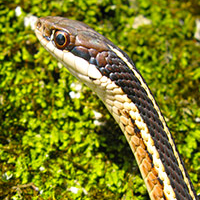Eastern ribbonsnake
Scientific name: Thamnophis sauritus

Cover photo credit: Rob Tervo
Status
Special Concern
“Special Concern” means the species lives in the wild in Ontario, is not endangered or threatened, but may become threatened or endangered due to a combination of biological characteristics and identified threats.
Date added to the Species at Risk in Ontario List
The Eastern Ribbonsnake was already assessed as a species of special concern when the Endangered Species Act took effect in 2008 and was re-assessed as special concern in 2013.
Read the report (PDF)
What it looks like
The Eastern Ribbonsnake is a slender snake with three bright yellow stripes running down its back and sides, contrasting sharply with its black back. Eastern Ribbonsnakes have a white chin, whitish-yellow belly and a distinct white crescent in front of each eye that can be used to distinguish it from a gartersnake. Adults grow to about 70 centimetres long, and females are typically larger than males.
Eastern Ribbonsnakes are active during the day and feed primarily on amphibians, particularly frogs.
An adult female gives birth to between five and 12 live young in late summer. The newly born snakes are independent and begin hunting for insects to eat almost immediately.
Where it lives
The Eastern Ribbonsnake is usually found close to water, especially in marshes, where it hunts for frogs and small fish. A good swimmer, it will dive in shallow water, especially if it is fleeing from a potential predator. At the onset of cold weather, these snakes congregate in underground burrows or rock crevices to hibernate together.
Where it’s been found in Ontario
The Eastern Ribbon Snake is found from southern Ontario west to Michigan and Wisconsin (isolated pockets), south to Illinois and Ohio, and east to New York State and Nova Scotia, where there is an isolated population. In Ontario, this snake occurs throughout southern and eastern Ontario and is locally common in parts of the Bruce Peninsula, Georgian Bay and eastern Ontario.
View a larger version of this map (PDF)
What threatens it
Although there is little historical data on the occurrence of this species in Ontario, it is likely that the Eastern Ribbonsnake has declined or even disappeared from many parts of southwestern Ontario due to the extensive loss of wetland and shoreline habitat in that region. The ongoing conversion of wetland to agricultural and urban uses, shoreline development and other habitat loss continues to be the main threat to this species in Ontario.
Other threats to the Eastern Ribbonsnake include declines in amphibian prey, persecution by people who mistakenly believe the species to be dangerous, road mortality, and predation by pets and subsidized predators.
Action we are taking
Special concern species do not receive species or habitat protection.
What you can do
Report a sighting
- Report a sighting of an endangered animal or plant to the Natural Heritage Information Centre. Photographs with specific locations or mapping coordinates are always helpful.
- Watch for snakes that may be crossing roads between May and October. Road mortality is a serious threat to snakes because they are slow moving, hard to see on the road and are sometimes intentionally run over. If it is safe to do so, help snakes across the road in the direction they were headed.
- Visit the Ontario reptile and Amphibian Atlas (www.ontarionature.org/atlas) or Toronto Zoo Adopt-a-Pond website (www.torontozoo.com/Adoptapond) to learn more about Ontario’s rare snakes, their habitat and related conservation initiatives.
Volunteer
- Volunteer with your local nature club or provincial park to participate in surveys or stewardship work focused on species at risk.
Be a good steward
- Private land owners have a very important role to play in species recovery. You may be eligible for stewardship programs that support the protection and recovery of species at risk and their habitats.
Report illegal activity
- Report any illegal activity related to plants and wildlife to
1-877-TIP-SMNR (847-7667) .
Quick facts
- If a ribbonsnake is captured and handled roughly, it will attempt to escape by squirming wildly and exuding a foul smelling musk to entice its captor to release it.
- Another more common Ontario species, the Eastern Gartersnake, has similar colours and markings to the Eastern Ribbonsnake, making identification in the field tricky. However, the white crescent-shaped marking in front of the eye can be used to quickly identify a ribbonsnake.
- Many species of snakes lay eggs, but Eastern Ribbonsnakes give birth to live young.
- Like all snakes, Eastern Ribbonsnakes swallow their food whole and can swallow an animal that is much larger than their own head.
